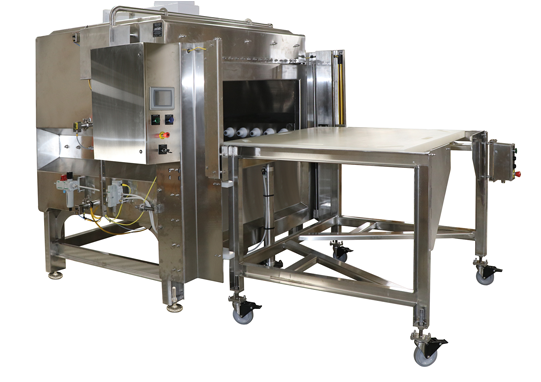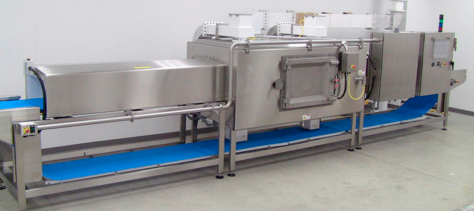Industrial microwaves can use metal because they are designed with variable frequencies and enhanced shielding to prevent arcing and ensure even heating.
Design and Function
Tailored Microwave Frequencies
Industrial microwaves often feature adjustable or multiple frequency settings, which serves to manage how microwave energy interacts with metal objects . At standard home microwaves, the frequency is typically fixed at about 2.45 GHz. Industrial units are capable of changing their frequency with the intention of avoiding electrical arcing among other issues. This further serves to focus the energy in a more even manner and reduce the likelihood of hotspots or sparks, both common in household microwaves when confronted with metal. Similarly, changing the frequency can optimize the heating process with regards to the material heated, such as drying of metallic inks or curing metal laden materials used in manufacturing.
Enhanced Shielding and Material Use
Industrial microwave construction includes additional shielding and makes use of specific materials that can withstand high temperatures and direct microwave radiation without any issues . This further serves to protect the machine and equally limits the emission in the working space. The shielding process facilitates efficient containment of microwaves and the prevention of hazards that might arise due to windows. For instance, this is invaluable when the industrial microwave includes metal, which may be exposed when heated and must remain securely within the microwave.
Customizable Interior Design
Depending on the production process, industrial microwaves are often designed that allows for reconfiguration of the inside part or addition of elements that facilitate the placement of metal . In the stat pharma industry, for instance, metal trays are used to ensure uniform heating. The particular dimensions of the tray influence the overall size of the oven, thus equally influencing the optimal placement of metal trays, so as to ensure the microwave heats as efficiently as possible without causing sparks. The wide array of such characteristics supports different uses of the industrial microwaves.
Application-Specific Examples
In the food industry, microwave heating is often rapid, with industrial microwaves including metal such as conveyors or shelves to facilitate faster heating rates . In such ovens, manufactured goods are heated on metal trays, which can facilitate up to a 50% decrease in the overall heating time, when compared to non-metal trays. Metal trays can equally limit the amount of energy consumption and heating time in specialized pharmaceutical production. By designing metal parts of the tray to ensure they do not interfere with the microwave’s energy field, their presence does not impact the status of food processing and the working order of the microwave. Such innovative design choices and the impact of functional adaptations help to utilize industrial microwaves even in high-demand environments.

Different Microwave Technology
Different Microwave Technology
Household microwaves and those used in industrial processes are very different. Industrial microwaves rely on modern microwave technology, which is more suitable for particular industrial needs, including the safety of metals within the microwave chamber.
Variation in Microwave Frequencies to Suit Industrial Requirements
Most industrial microwave systems use different frequencies apart from just one. This helps in tailoring them towards specific materials and applications, which reduces the likelihood of the destructive interaction witnessed when a metal is placed in the standard domestic microwave. For example, industrial microwaves may work at 2.45 GHz while having the capacity to switch to a low or high frequency, depending on the load and materials involved. This variation in frequency helps in maximizing the context of the material, including metals, which need to be heated without sparks or overheating in one section.
Advanced Magnetron Arrangements
The magnetron is the most essential part of any microwave technology, as it produces microwaves. Industrial microwaves use superior magnetron designs which can accommodate higher power outputs and longer duty cycles. The longer duty cycle means that once the materials are in the chamber, they can be used for hours on end to process metals. Newer and improved technology ensures that arcing when a metal object is introduced does not occur. In the standard setup, a typical home microwave would include a magnetron rated at about 1 kW. In contrast, industrial magnetrons are rated at 3 kW or even higher, thus offering the energies required to process materials at a level deemed satisfactory for industrial processes.
Use of Metal and Energy Absorption Variation
In household microwaves, metal objects cause the risk of causing fires because of the microwaves reflected by the metals. In industrial microwaves, designers and engineers maximize the use of reflections caused by metals in the heating process. The metals are uniquely shaped, such as in the use of the silverware which has narrow points, to ensure reflectivity of microwaves and increase their uniform distribution within the microwave chamber. The metals are also placed strategically to allow the microwave energy to hit certain spots or to be distributed evenly. The ability of metals to reflect microwave energy helps in heating the materials at a faster rate and more uniformly, compared to when there are no metal objects within the chamber. A perfect example of where this technology is applicable is in the curing of metallic paints and glues. The company adjusts the frequency and power of the microwave to ensure that the metallic particles are heated, as required, by and large improving the speed and quality of the curing process. It can save up to 75% of the curing time that would have been needed using other heating methods. It also reduces energy use by up to 50%, making it cheaper for the company to cure without using electric bulbs.

Controlled Environment
Uses of Metal in Microwaves
Although many household microwaves warn against using metal inside them, it is not uncommon to use metals in industrial microwaves for a variety of processes. From drying paint to the annealing of metal sheets, these heavy duty devices can use and process metals without any of the problems that might arise in a household device. The key distinction between industrial and household microwaves in this regard is the controlled environment in which the former operate. These devices utilise several features to ensure that the metal does not interfere with its operations, such as precision in microwave intensity and placement, temperature and humidity control within the chamber, and real-time monitoring and feedback systems.
Precision in microwave intensity and placement
According to Patterson, Barnett, Pole, and Flynn, industrial microwaves are equipped with sophisticated control systems which allow for unprecedented degree of precision in the placement and intensity of microwaves . As such, it is possible to adjust the energy levels to exactly the properties of the metal which the microwave will be expected to process. For example, when drying pharmaceutical pills with a metallic coating inside a measure of citric acid, the microwave can be set to emit an extremely low power, preventing the metal from heating enough to ignite, while still providing enough energy to process the rest of the pill. Failure of coal can develop between 500 to 800 watts, although 500 milliwats of reflective energy is considered the safe limit . The pills themselves contain around 200 milliwats of GPS for processing.905455
Temperature and humidity control
Temperature and humidity are critical factors in preventing condensation on metal and subsequent sparking or uneven heating. As such, the insides of the industrial microwaves feature tightly controlled environments of very low humidity. For example, when drying metallic ink printed on paper, the insides of the microwave chamber do not exceed 5% of humidity. On the chamber’s floor, a thin layer of silica is placed, which absorbs all the moisture from the chamber and desiccates the paper. Conditioning the air inside the microwave to such a low level of humidity prevents sparking, as there is no water on the metallic ink to coalesce and develop. Prior to burning secondary reflection on the infrared machines, the microwave also works only for around half an hour the pills, leaving the inside cool at around 45 degrees to prevent vapours from forming on the ink judged to be sparking and potentially unsafe.






